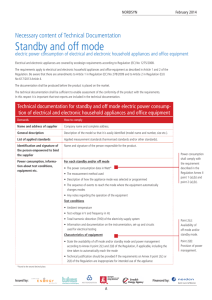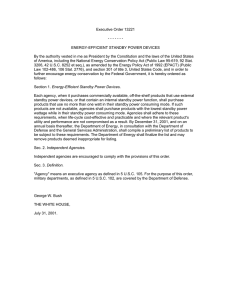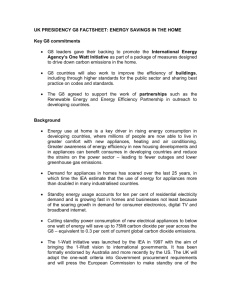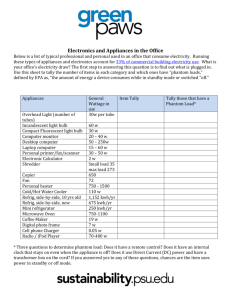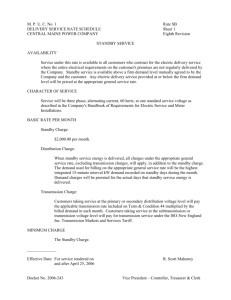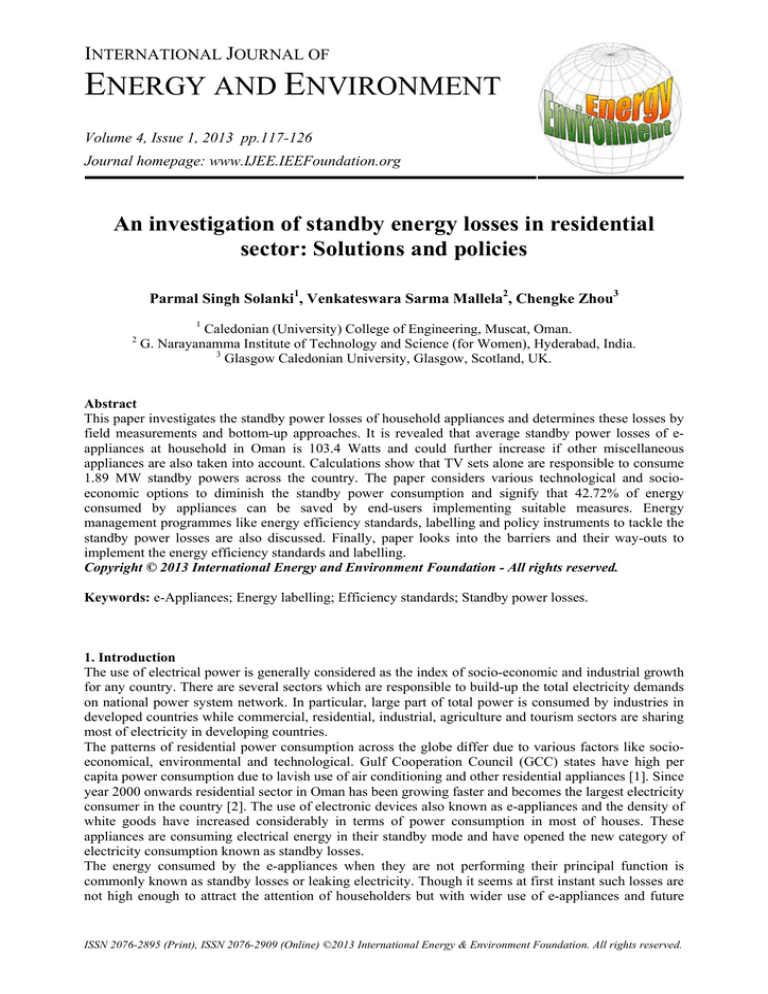
INTERNATIONAL JOURNAL OF
ENERGY AND ENVIRONMENT
Volume 4, Issue 1, 2013 pp.117-126
Journal homepage: www.IJEE.IEEFoundation.org
An investigation of standby energy losses in residential
sector: Solutions and policies
Parmal Singh Solanki1, Venkateswara Sarma Mallela2, Chengke Zhou3
1
2
Caledonian (University) College of Engineering, Muscat, Oman.
G. Narayanamma Institute of Technology and Science (for Women), Hyderabad, India.
3
Glasgow Caledonian University, Glasgow, Scotland, UK.
Abstract
This paper investigates the standby power losses of household appliances and determines these losses by
field measurements and bottom-up approaches. It is revealed that average standby power losses of eappliances at household in Oman is 103.4 Watts and could further increase if other miscellaneous
appliances are also taken into account. Calculations show that TV sets alone are responsible to consume
1.89 MW standby powers across the country. The paper considers various technological and socioeconomic options to diminish the standby power consumption and signify that 42.72% of energy
consumed by appliances can be saved by end-users implementing suitable measures. Energy
management programmes like energy efficiency standards, labelling and policy instruments to tackle the
standby power losses are also discussed. Finally, paper looks into the barriers and their way-outs to
implement the energy efficiency standards and labelling.
Copyright © 2013 International Energy and Environment Foundation - All rights reserved.
Keywords: e-Appliances; Energy labelling; Efficiency standards; Standby power losses.
1. Introduction
The use of electrical power is generally considered as the index of socio-economic and industrial growth
for any country. There are several sectors which are responsible to build-up the total electricity demands
on national power system network. In particular, large part of total power is consumed by industries in
developed countries while commercial, residential, industrial, agriculture and tourism sectors are sharing
most of electricity in developing countries.
The patterns of residential power consumption across the globe differ due to various factors like socioeconomical, environmental and technological. Gulf Cooperation Council (GCC) states have high per
capita power consumption due to lavish use of air conditioning and other residential appliances [1]. Since
year 2000 onwards residential sector in Oman has been growing faster and becomes the largest electricity
consumer in the country [2]. The use of electronic devices also known as e-appliances and the density of
white goods have increased considerably in terms of power consumption in most of houses. These
appliances are consuming electrical energy in their standby mode and have opened the new category of
electricity consumption known as standby losses.
The energy consumed by the e-appliances when they are not performing their principal function is
commonly known as standby losses or leaking electricity. Though it seems at first instant such losses are
not high enough to attract the attention of householders but with wider use of e-appliances and future
ISSN 2076-2895 (Print), ISSN 2076-2909 (Online) ©2013 International Energy & Environment Foundation. All rights reserved.
118
International Journal of Energy and Environment (IJEE), Volume 4, Issue 1, 2013, pp.117-126
development of households, a substantial increase in standby power is expected unless sufficient efforts
are made at the national level. Many research scholars and professional organisation have discussed the
energy consumed by e-appliances during their standby mode and stated as standby losses [3-5].
Definitions of the standby losses used in the scientific literature are however not consistent and some
variation has been observed. Definition stated by Nakagami et al. [6] and Molinder et al. [7] have slight
variation then what international energy agency (IEA) has adapted. The definition suggested by IEA is
widely accepted and defined as follows [8]:
“The standby power use depends on product being analysed. At a minimum standby power includes
power used while product is performing no function. For many products, standby power is the lowest
power used by performing at least one function”.
Standby power losses are not limited to up to e-appliances rather impressing their presence in other
commonly used household appliances like air-conditioners, freezers, refrigerators, microwave oven and
washing machines. Sometimes these appliances essentially need small amount of electricity to maintain
signal reception capability i.e. remote control, monitoring temperature, powering internal clock and
continuous display. Though loss of such kind is relatively low but combined effect of all appliances
whose power consumption varying from less than 1 Watt to 21 Watts are having significant effects on
total household electricity consumption [9]. For instance in the United States, standby losses accounts for
about 5% of total residential electricity while 15% in Italy [10]. Figure 1 shows the standby power loss of
developed and developing countries vary up to 10% due to various social and technological factors. It is
revealed in a report issued by IEA that by 2030, 15% of total appliance electricity consumption in
Europe could be for standby power functionality which is currently unregulated [11].
Figure 1. Standby power losses as a fraction of total electricity used at residential sector [10-12]
Now standby power consumption is a global phenomenon because most of the electronic and other
household appliances are manufactured by the large multinational companies and their products are
identical across all countries. Therefore data gathered in a country may be applicable to others as well
except some variation due to socio-economic environment and duration of appliance usages. The
scenario of standby losses in residential sector of GCC states is not very much decaling than other
developed countries. Albeit no detailed field surveys is available for each GCC state, however a rigorous
survey conducted by author for Oman revealed that penetration of white goods and e-appliance is
increasing demand by 12.30% of total household electricity per annum and this trend will continue.
Penetration of appliances in terms of electricity consumption of a typical house during 2007 and 2008 is
shown in Figure 2. Substantial plunge in energy consumption observed in Figure 2 during first week of
June 2007 due to a cyclone GONU forced to shut down power supply for a couple of days.
This paper investigates the electricity used by household appliances in standby mode followed by
solution and policies to mitigate these losses. Paper is organised in six sections. Section 1 introduces the
general overview and scenario of standby losses in residential sector of developed and developing
countries. Section 2 describes the mode of operation of appliances and estimates the standby power
consumption in context to Oman supported by a sample calculation in Appendix. Section 3 presents the
ISSN 2076-2895 (Print), ISSN 2076-2909 (Online) ©2013 International Energy & Environment Foundation. All rights reserved.
International Journal of Energy and Environment (IJEE), Volume 4, Issue 1, 2013, pp.117-126
119
short and long term solution to mitigate standby power. Long term solutions need the national policies on
energy management programmes like energy efficiency standards, labelling and international
technological collaboration which are covered in Section 4. The probable barriers and way-outs of
energy efficiency standards and labelling programmes are discussed in section 5 while paper is
concluded in section 6
Figure 2. Energy consumption of a typical house and penetration of e-appliances
2. Mode of operation and standby power
Most of appliances when plugged to power supply, work in two modes like ON and OFF as shown in
Figure 3. During on mode, an appliance actively performs the expected output and consumes the nominal
power while in off mode the device is not performing any function. During off position if the appliance is
energised by power supply, some power is continuously consumed by the transformer and switching
circuit unless the switch is placed in primary side of power supply. In standby mode the appliance
execute some functions like to activate the internal circuit to receive the remote control signal, internal
timer and to enable the internal clock.
2.1 Estimation of standby power consumption
Bottom-up and online measurement in field are widely used methods to estimate the standby power
consumption. In this study both methods are used to resolve the complexity of required data collection.
The parameters of interest in bottom-up approach are average standby power consumption, operating
time in standby mode and ownership i.e. saturation level of household appliances. A rigorous household
survey was conducted in 226 sample representative houses to collect the saturation level and average
household electricity consumption [13]. Some significant facts were also noted during survey which
could be helpful in framing the solutions and policies to mitigate standby losses. For instance it is noted
that 79% of householders were innocent with fact that though appliance not producing output but still
consuming power for standby functions while 81% end-users are unknown with procedure to keep the
appliance in sleeping or least energy consumption mode.
The standby energy consumption ( SEC ) during a day is expressed by following equation.
SEC = Ps × Ts
(1)
where, Ps is the average real power (Watts) consumed by appliance in standby power mode obtained for
a specific appliance and obtained from the physical measurements or product specification literature
while Ts , is the standby rate which is the ratio of the time spent in standby mode for corresponding
appliance in a day and may determine by the following equation [14].
ISSN 2076-2895 (Print), ISSN 2076-2909 (Online) ©2013 International Energy & Environment Foundation. All rights reserved.
International Journal of Energy and Environment (IJEE), Volume 4, Issue 1, 2013, pp.117-126
120
Ts =
tsb
tsb + toff
(2)
where, t sb is standby mode duration and t off is the time spend by appliance in off mode. The total
standby energy consumption of appliance k in a household is given by the following equation [15]
ESEC ,k = SECk × Dk
(3)
where, Dk is the saturation rate of appliance k .
If standby energy consumed by k th appliance is ER,s then total energy consumed by residential
appliances is given by equation [3, 15]
k =m
∑ = ∑ ESEC ,k
R ,s
(4)
k =1
Household Appliances
Power Supply
Plugged ON
Plugged Off
ON
OFF
No Consumption
Soft OFF
Hard Off
No Power Consumed
Standby
Active
Nominal Power Use
Passive Mode
Active Mode
Standby Power Mode Consumption
Figure 3. Block diagram of standby power [10]
The standby energy consumed by various household appliances is estimated and for few similar
appliances, the online average data at different houses in Oman are recorded using a Watt Meter
calibrated to measure power at low levels. The average power measured and energy consumed per day is
shown in Table 1.
ISSN 2076-2895 (Print), ISSN 2076-2909 (Online) ©2013 International Energy & Environment Foundation. All rights reserved.
International Journal of Energy and Environment (IJEE), Volume 4, Issue 1, 2013, pp.117-126
121
Table 1. Standby power of household appliances
Name of Appliances
Television: CRT, 21'
TV Digital Satellite Receiver
DVD Player
Play Station
VCR
PC (Monitor)
Computer Speaker
Laptop
Printer
Mobile Charger
Microwave Oven
Measured Power (W)
Avg. Max
Avg. Min
78.10
10.96
32
21.10
30
16.99
15
3.98
60
4.10
65.10
7.94
14.90
5.97
29.97
3.90
55
13.10
1.51
0.52
1200
14.89
Measured
Energy (kWh)
0.649
0.56
0.43
0.12
0.19
0.41
0.17
0.22
0.18
0.03
0.90
Saturation
Level (%)
77
92
85
56
69
56
65
78
66
189
49
It can be seen from the Table1, the minimum average household standby power consumption is 103.45
Watts and this amount could further increase if refrigerator, fridge, air-conditioners and other
miscellaneous device having average saturation level more than 85% are taken into account. Sample
standby power calculation of an appliance is shown in Appendix and the percentage share of energy
consumed by appliances during active and standby mode is shown in Figure 4. It can be seen from the
Figure 4, in some cases the percentage of standby energy consumed is more than the energy consumed
during active mode by respective appliance. Further it can be noted that around 42.72% of total energy
consumed by appliances is passive i.e. in standby mode and can be saved by end-users through switching
off the respective appliances from the wall socket and procuring efficient product. It is worth to note that
nationwide the TV sets alone is consuming about 1.89 MW standby powers.
Figure 4. Energy consumed by appliances in active and standby modes
3. Solutions to mitigate standby power
There could be two ways to mitigate the standby losses like using short term programme and long term.
Short term solution is based on consumer side activities and technological changes while the long term
solutions are underpinning the appropriate national policies. Consumers must aware and realise that
appliances which equipped with remote control, digital display system, internal/digital clock, battery
charger and soft touch key-pad are generally draw standby power. Following subsections brief about
short and long term remedial action while section 4 describes the policies in length.
3.1 Short term solution
Short term activities which could provide viable solutions are described as follows:
• Unplug the appliances which are rarely used like TV in special guest room. Use the power strip with
a switch to control clusters of appliances like computer clusters mainly include the personal
ISSN 2076-2895 (Print), ISSN 2076-2909 (Online) ©2013 International Energy & Environment Foundation. All rights reserved.
122
•
•
•
•
International Journal of Energy and Environment (IJEE), Volume 4, Issue 1, 2013, pp.117-126
computer display, printer, scanner, speakers and wireless transmitter. Similarly other clusters like,
audio and visual system.
Replace the old and inefficient household appliances by the energy efficient product. For instance a
study carried out by Energy Conservation Center of Japan revealed that by replacing the existing old
appliances with the latest appliances equipped by modern technology could save almost 43% of its
standby power.
Many e-appliances available are equipped with built-in power management system which either not
known to the end-users or they are unable to facilitate the power management feature of the
equipment which could save about 15 to 20% of standby electricity [11]. Therefore a national level
awareness campaign among the end-user could enhance the possibility of standby power savings.
Redesigning the appliance circuits and facilitating two power-saving modes in the product.
Providing technological solutions to the local industries like more energy efficient switches,
integrated circuits, power management software, advanced power supplies and charging devices.
3.2 Long term solution
Most of e-appliances and white goods in local Omani market are imported from other countries and often
declined to follow the energy efficiency performance standards. In the absence of legal energy
performance regulations in Oman, number of low energy efficient e-appliance is penetrating the
household faster than any other appliance and increasing the household consumption by average 12.30%
every year. These low energy efficient products are generally lower in price than a product manufactured
under rigorous quality control and able to attract the end-user procurement. Eventually this is also
contributing to high standby losses.
To control such inefficient appliance issues, a framework of federal energy management programme is
essential. In long term programme, an explicit policy to introduce the energy efficiency standards,
labelling and international collaboration to harmonise the products is inevitable.
4. Policies to curtail standby power
The experience gained around the world shows that energy efficiency standards, voluntary labelling and
technological collaboration are appear to be the most widely used approaches for solving the issues of
standby power losses. This section presents a study of Energy Efficiency Standards and Labelling
(EES&L) and international collaboration programmes as policy instruments to curtail standby losses and
harmonised the product with regulatory schemes.
4.1 Energy efficiency standards
Energy Efficiency Standard (EES) is a set of procedures and regulations that prescribe minimum energy
performance i.e. optimum utilisation of energy of an energy-consuming product or e-appliance. These
standards can be either mandatory or voluntary to act as tools for market transformation. A compulsory
EES is normally most effective means to enhance the energy competence and set up energy efficiency
benchmark of appliances [16, 17]. There are two methods like statistical and engineering/economic
which are extensively used across many countries.
In GCC region, Saudi Arabia is first member state initiated National Energy Efficiency Programme
(NEEP) to meet the rapidly growing power and energy demand through efficient and rational
consumption patterns. On April 27, 2010, Saudi organisation SASO has implemented new energy
labelling programme for household appliances. Similarly United Arab Emirates government has
introduced new energy efficiency programme in the country under the vigilance of Emirates Authorities
for Standardisation and Metrology (ESMA) aiming to adhere the set energy standards by imported or
manufactured electronic goods for energy conservation [18]. Socio-economically the Oman is also
having similar conditions as their neighbour GCC states. Therefore implementation of EES is inevitable
for tangible solution to address the standby losses imposed by inefficient appliances in local market.
4.2 Energy efficiency labels
The intention of introducing labels is to convince end-users as well as manufacturers to procure and
design more efficient appliances. Labels should enable the comparison of energy efficiency and
electricity consumption cost for similar appliances that compete with types having similar dimensions
and characteristics. The energy label concept can be classified in the following three types [19].
ISSN 2076-2895 (Print), ISSN 2076-2909 (Online) ©2013 International Energy & Environment Foundation. All rights reserved.
International Journal of Energy and Environment (IJEE), Volume 4, Issue 1, 2013, pp.117-126
•
•
•
123
Labels with General Information: This label is frequently used for kitchenware and other home
appliances. They primarily include information about efficient methods of home appliances and ways
to use these devices in order to achieve the maximum energy efficiency
Labels with Energy Costs: This type of label is typically used for refrigerator, freezer and washing
machines. Energy cost for one year of operation are listed for average price of energy and for the
price offered by local distribution company.
Labels with Energy Efficiency: This type of label is generally used for temperature responsive
appliances particularly air-conditioners. Appliances are compared energy efficiency or the price of
energy for operation of a specific time period. The label must include a graph comparing the product
to other types as well as information on how to use the product most efficiently.
4.3 Implementation of EES& labels
There are four essential steps which could be taken in order to establish appliance EES and labels. The
simplified hierarchy of such programme is described by Stephen et al. and Yanti et al. [19, 20] in four
steps as follows:
• Step-1: The first step is to establish the test procedure. An energy performance test procedure is the
foundation for energy efficiency standards, energy labels and other related programs. It provides the
manufacturers, regulatory authorities and consumers a way of consistently evaluating energy use
across different types and models of appliances.
• Step-2: The second step is to set up an efficiency standard based on appliance efficiency survey and
test data. Appliances have to be tested with one of the test procedures and standard when it is sold in
the market. The test data can also be used to accelerate the time of setting standards.
• Step-3: The third step is to develop an energy label. Labels are useful to educate consumers; however
it is not really necessary for standards. The energy labels could contribute to further potential savings
from the standards.
• Step-4: The last step is to give some incentive programs as an option for standards and labels.
4.4 International collaboration
Energy efficiency standards and labelling may provide the viable solution to reduce the standby losses
but at the same time there may be few concerns among the policy makers and stake holders. For instance
any increase in appliance production cost to abide the minimum standby power losses criterion will
restrain the reach of product to end-users. The difference in standards and energy specifications criteria
of a particular country can create harmonised issues and trading complexities with other country.
The above shortcoming could be addressed by establishing the international collaboration among
countries by developing universally accepted solution. International Energy Agency, International
Energy Star and Asia Pacific Economic Cooperation are the major organisations working in several
countries to provide the legal frameworks for international co-operation and defining the limits of
standby power use. The “Energy Star” label of the United States Environmental Protection Agency (USEPA), which takes into consideration the standby power use of e-appliance, have the world wide
recognition and have adopted by several countries for defining the limits of standby power consumption.
5. Barriers and way-out of EES & label
Technically it is possible to diminish standby losses in most appliances however there are some obstacles
which need to be addressed. Identified barriers and their solutions to implement EES &Label are widely
spread from national policies to end-users. The key barriers and their way out are as follows:
• The biggest barrier is the absence of policy and regulatory framework for EES & Label. As of today
there is no authorised institution or technical committee in Oman which could suggest the national
energy policy or minimum energy performance related issues. The other hurdles are the short and
long term funding for supporting EES & Label programmes and developing the energy performance
testing facilities in the country. These barriers can be address at national level by constituting a
technical committee considering members from all stakeholders. The committee experts could assist
the government to design the energy policy.
• Without a policy framework that encourages EES & Labels for energy appliances, manufacturers
will tend to produce lower cost inefficient products. In order to overcome this barrier, it is important
to strengthen an understanding among policymakers to draft a policy catering incentives for
manufacturers as well as ensuring strict compliance of the framed policy.
ISSN 2076-2895 (Print), ISSN 2076-2909 (Online) ©2013 International Energy & Environment Foundation. All rights reserved.
124
•
•
•
•
International Journal of Energy and Environment (IJEE), Volume 4, Issue 1, 2013, pp.117-126
Manufacturing of energy efficient appliances is not a common practice due uncompetitive market
environment (mostly dependent on imported products), old manufacturing processes and lack of
local product demands. Sometimes prohibiting the sale of products where energy consumption is
higher than the minimum standard. Another barrier responsible for inefficient product is
unavailability of quality raw material at lower price compels manufacturers to use low cost, hence
low quality material leading to production of energy inefficient products. These barriers could be
addressed by providing technical assistance/ international collaboration for manufacturers to improve
energy efficiency and promote the local product in the market.
In many sectors energy consumption gets less attention for innovation than production, speed,
comfort and design appeal. This is probably due to payback times may only be a few years while the
required investments can be a barrier for business enterprises or households. Energy service
companies could have a stimulating role in this. They could pre-finance these investments and be
paid back through the energy bill, but this has yet to be widely developed as the service companies
themselves are taking substantial subsidies from the government.
Up to now, the most important instrument that governments have used to motivate innovation is the
funding of research and development by establishing the research council (under royal decree
54/2005). The issue is that research and development funding only concerns the input of the
innovation process, not the output. Therefore Innovation needs more than just research and
development and it is vital to create markets for the deployment of energy efficiency measures.
End-user awareness about benefits of energy efficiency is another major barrier in implementation of
EES & Label system. A common man does not have the awareness of initial cost versus the recurring
cost, so initial cost effectiveness is the basic buying criteria of consumer, instead of durability or
energy efficiency. In addition, quality or efficiency is not the major focus of manufacturers as the
consumer does not demand energy efficient product. These barriers will be addressed by launching
awareness campaigns for consumer awareness.
6. Conclusion
The energy consumed by the appliances when they are not performing their principal function is known
as standby losses and their combined outcome have significant impact on the household electricity
consumption. In paper investigation of standby losses and their mitigation in context to Oman is
elaborated. Following are the key outcomes.
• It is revealed that e-appliances are penetrating in residential sector by 12.30% of total household
electricity consumption per annum. Average household standby power consumption is 103.45 Watts
and the standby energy consumption could further increase if other commonly used appliances like
refrigerator, fridge, air-conditioners and miscellaneous device are taken into account.
• Results indicate that some e-appliances when ON from wall socket consume rather more power in
standby mode than its active mode of operation.
• Nationwide TV sets alone are responsible to consume 1.89 MW power during standby mode. The
combined effect of standby power consumed by all e-appliances is significantly imperative and
insists the need of greater efforts to address the power loss issues.
• It may be possible to save 42.72% of energy consumed by e-appliances during standby mode if short
terms measures like unplug the appliances from wall socket, switch to control clusters of appliances,
use of energy efficient product and standby power awareness campaign among the end-users.
• The long terms measures like energy efficiency standards, labelling and international technological
collaboration programmes to enhance the efficiency of product are to be implemented at national
level under federal energy policies.
• Pilot programmes can be implemented to evaluate the barriers and to address the way-out of long
terms programme for viable solution of standby losses. The huge outturn subsidies of US$287.51
million [21] on electricity allotted to end-user and other stockholders could be diverted for
development and procurement of energy efficient products.
Appendix
Television is one of the common appliances widely used in residential sector of Oman. Around 85%
rural and 69% of urban houses are equipped with CRT type of TV set in 2008, which consume 78.10
Watts during active mode
(P )
ak
( )
and 10.96 watts in standby mode Psk . The average electricity
ISSN 2076-2895 (Print), ISSN 2076-2909 (Online) ©2013 International Energy & Environment Foundation. All rights reserved.
International Journal of Energy and Environment (IJEE), Volume 4, Issue 1, 2013, pp.117-126
125
consumed in day for similar sets at different house is recorded as 649 Watt-hour. It is assumed appliance
( k ) is TV and it is in active mode for ta hours while in soft off for ts hours.
ta + ts = 24 Hours ⇒ ta = 24 − ts
Total Energy Consumed / day = Pa k × ta + Psk × ts
⇒ 649 = 78 × ta + 10.96 × ts
⇒ ta = 5.74 Hours and ts = 18.25 Hours
The energy consumed by the TV in active and standby modes becomes
Eak = 0.448 kWh and Esk = 0.200 kWh
It is significant to note that 30.82% of total electricity consumed by TV per day is from standby mode
which is leading about 6 kWh per household per month.
Nationwide, number of house ( H ) are taken as 295075[21, 22], with 77% ownership rate ( Dk ) of TV
sets. The nationwide standby power consumed by TV alone ( Pn ,sk ) may be evaluated by the equation.
⎡ 0.200
⎤
Pn ,sk = ⎢
× H × Dk ⎥ = 1.89 MW
3
⎣ 24 × 10
⎦
Acknowledgements
The authors acknowledge the support and cooperation given by the authorities of Caledonian
(University) College of Engineering, Oman and Glasgow Caledonian University, Glasgow (UK). The
policies and other discussion in paper are merely author’s independent views which neither reflects nor
obligatory to any concern authorities.
References
[1] Mohammed Redha Qader. Electricity Consumption and GHG Emissions in GCC Countries.
Energies 2009, vol. 2, pp. 1201-1213, 2009, doi: 10.3390/en20401201.
[2] Parmal Singh Solanki. Demand Side Management Strategies to Regulate Electricity in Oman.
Doctoral Thesis, Glasgow Caledonian University, 2012.
[3] Chakraborty A. and Pfaelzer A. An overview of standby power management in electrical and
electronic power devices and appliances to improve the overall energy efficiency in creating a
green world. Journal of Renewable and Sustainable Energy 3, pp. 023112-18, 2011.
[4] Alan Meier, Wolfgang Huber and Karen Rosen. Reducing Leaking Electricity to 1 Watt.
Lawrence Berkeley National Laboratory, Berkeley, CA, 2000.
[5] Meier A., Rainer L., and Greenberg S. Miscellaneous electrical energy use in homes. Energy
17:509, 1992.
[6] Nakagami Hidetoshi, Akio Tanaka, Chiharu Murakoshi. Standby-by Electricity Consumption in
Japanese Houses. Jyukanko Research Institute, Japan, 1997.
[7] Molinder Olof. Study on Miscellaneous Standby Power Consumption of Household Equipment.
Omvarden Konsult AB, EU-DG XVII, contract 4.1031/E/96-008, 1997.
[8] International Energy Agency. Workshop on international action to reduce standby power waste of
electrical equipment. IEA, 1999, webpage www.iea.org/standby/outcomes.htm.
[9] Alan Meier. A Worldwide Review of Standby Power Use in Homes. Lawrence Berkeley National
Laboratory. Work supported by Energy Efficiency and Renewable Energy, Building technologies,
US Department of Energy, DE-AC03-76SF00098, 2003.
[10] Mercy Violet Shuma-Iwisi. Estimation of Standby Power and Energy Losses in South African
Homes. Doctoral Thesis, University of the Witwatersrand, Johannesburg, 2009.
[11] Brahmanand Mohanty. Standby Power Losses in Household Electrical Appliances and Office
Equipments. UN-ESCAP, Regional Symposium on Energy Efficiency Standards and Labelling,
pp. 1-25, 29-31 May 2001.
[12] Michael Camilleri, Andrew Pollard, Albrecht Stoecklein, Lynda Amitrano and Nigel Issacs. The
Baseload and Standby Power Consumption of New Zealand Houses. Paper No. 100, IRHACE
Technical Conference, Palmerston North, 2002.
ISSN 2076-2895 (Print), ISSN 2076-2909 (Online) ©2013 International Energy & Environment Foundation. All rights reserved.
126
International Journal of Energy and Environment (IJEE), Volume 4, Issue 1, 2013, pp.117-126
[13] Parmal Singh Solanki, Venkateswara Sarma Mallela, Malcolm Allan and Chengke Zhou. DSM
Strategy Based Effective Management of Households to Support Energy Sector. International
Review on Modelling and Simulations, Vol. 3, No. 4, pp. 613-621, 2010.
[14] Commission of the European Communities. Demand-side Management, End-use metering
campaign in 400 households of the European Community, Assessment of the potential electricity
savings. Eureco Project, January 2002.
[15] Swisher J N., Gilberto de Martino Jannuzzi and Robert Y Redlinger. Tools and Methods for
Integrated Resource Planning Improving Energy Efficiency and Protecting the Environment.
ISBN 87-550-2332-0, UNEP Collaborating Centre on Energy and Environment, EisØ National
Laboratory, Denmark, 1997.
[16] Masjuki H H., Mahlia T M I., Chaudhary A., Saidur R. A Literature Review on Energy Efficiency
and Labels for Household Electrical Appliances. Proceedings of TENCON 2000, Kuala Lumpur,
Vol. 2, pp. 103-107, 24-27 September 2000.
[17] Isaac Turiel, Terry Chan, James E McMohan. Theory and methodology of appliance standards.
Energy and Building, Vol. 26, Issue 1, pp. 35-44, 1997.
[18] Emirates Authority for Standardization and Metrology. Online: http://www.esma.ae, Accessed:
May 2011.
[19] Stephen Wiel & James, E. MacMohan. Energy Efficiency Labels and Standards: A Guidebook for
Appliances, Equipment and Lighting. 2nd Edition, Collaborative Labelling and Appliance
Standards Program, 2005. Online: www.clasponline.org, Accessed: July 2010.
[20] Yanti, P.A.A., Mahlia, T.M.I. Methodology of Implementing Energy Efficiency Standards for
Electric Motor. European Journal of scientific Research, Vol. 24, No. 1, pp. 134-147, 2008.
[21] Annual Report 2009. Authority for Electricity Regulation Oman. Al-Khuwair, Sultanate of Oman,
pp. 1-52, 2010.
[22] Annual Report 2010. Authority for Electricity Regulation Oman. Al-Khuwair, Sultanate of Oman,
pp. 1-49, 2011.
Parmal Singh Solanki received his PhD from Glasgow Caledonian University, Glasgow (UK) and
Master of Engineering in Power Systems from the University of Rajasthan, Jaipur (India). Presently he
is working as senior faculty member at Department of Electronics and Computer Engineering,
Caledonian (University) College of Engineering, Oman in affiliation with Glasgow Caledonian
University. Dr. Solanki is member of IEEE, IET, IE (India) and has published 15 research papers in
International Journal and conferences. His field of interest includes the Power Systems Analysis and
Demand Side Management in Electrical Power and Renewable Energy.
Venkateswara Sarma Mallela received his Bachelors Degree in Electrical Engineering from Govt
College of Engineering, Kakinada, Andhra University in 1974 and then obtained his Masters degree in
Electrical Engineering from Indian Institute of Technology, Madras. Later in his career he also obtained
his PhD degree in Electrical Engineering in 2004. Dr Mallela is currently working as a Professor at
Department of Electronics and Electrical Engineering, G. Narayanamma Institute of Technology and
Science (for Women), Shaikpet, Hyderabad, India and before joining to academics, he was a Senior
Scientist and Project Director at DRDL, DRDO, Hyderabad. He is a Fellow of IE and IETE, India. He is
also a Senior Member of IEEE. Prof. Mallela is having more than 38 years of research and teaching
experience. He has published more than 45 International Journal & conference papers in the areas of
Electrical Power Systems, Control System Engineering and Biomedical Engineering
Chengke Zhou received his B.Sc. and M.Sc. degrees in Electrical Engineering from HuaZhong
University of Science and Technology, China in 1983 and 1986, respectively, and Ph.D. degree at the
University of Manchester U.K., in 1994. Since then, he has worked in Glasgow Caledonian University,
U.K., as a lecturer, senior lecturer and in Heriot Watt University as a Reader until 2007 when he went
back to Glasgow Caledonian University as a Professor.
Prof. Zhou has published more than 120 papers in the area of Partial Discharge based condition
monitoring of MV/HV plant and power system analysis. He is actively involved in funded research
projects in UK and other countries. He is fellow and senior member of various professional societies.
ISSN 2076-2895 (Print), ISSN 2076-2909 (Online) ©2013 International Energy & Environment Foundation. All rights reserved.


